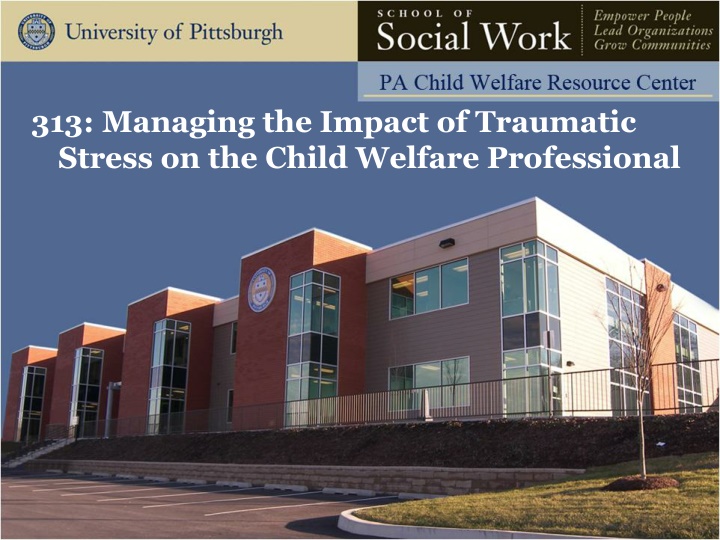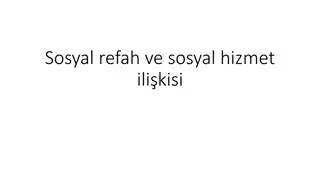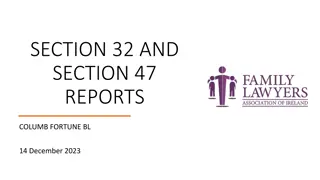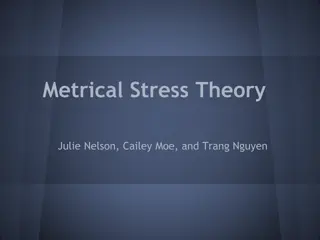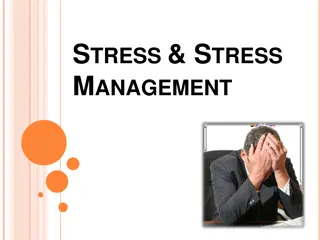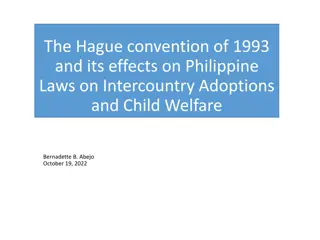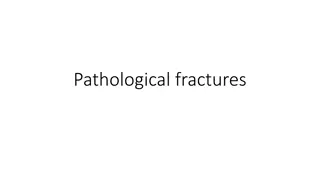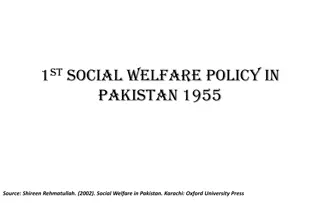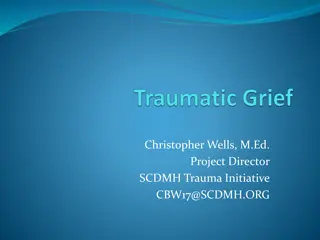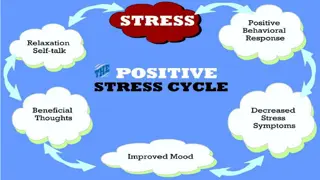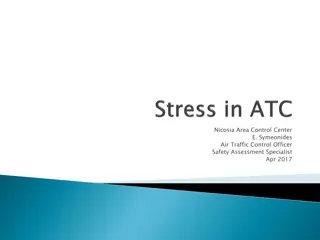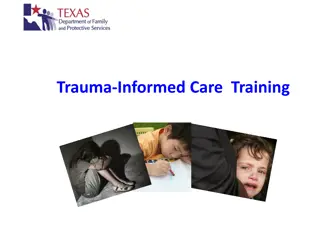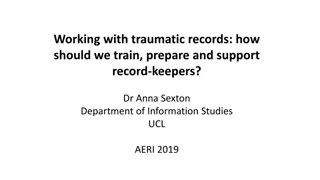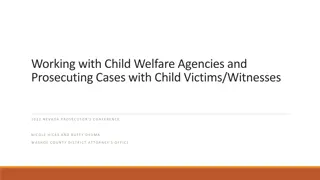Managing Traumatic Stress in Child Welfare Professionals
Learn to identify, recognize, and manage traumatic stress as an occupational hazard in the child welfare profession. This program helps professionals assess the impact of traumatic stress and personal strengths, develop strategies to promote resiliency, and understand the importance of safety and culture in managing traumatic stress.
Download Presentation

Please find below an Image/Link to download the presentation.
The content on the website is provided AS IS for your information and personal use only. It may not be sold, licensed, or shared on other websites without obtaining consent from the author.If you encounter any issues during the download, it is possible that the publisher has removed the file from their server.
You are allowed to download the files provided on this website for personal or commercial use, subject to the condition that they are used lawfully. All files are the property of their respective owners.
The content on the website is provided AS IS for your information and personal use only. It may not be sold, licensed, or shared on other websites without obtaining consent from the author.
E N D
Presentation Transcript
313: Managing the Impact of Traumatic Stress on the Child Welfare Professional
Learning Objectives Participants will be able to: Identify common terms associated with trauma relating to child welfare professionals; Recognize traumatic stress as an occupational hazard in the child welfare profession; Identify the symptoms of traumatic stress; Assess through self-reflection, the impact of both traumatic stress and personal strengths on one s personal and professional life; and Develop strategies to manage traumatic stress and promote resiliency. The Pennsylvania Child Welfare Resource Center 313: Managing the Impact of Traumatic Stress on the Child Welfare Professional 2
Agenda Welcome and Introductions What is Traumatic Stress? The Symptoms of Traumatic Stress The Impact of Traumatic Stress Strategies for Managing Traumatic Stress and Promoting Resiliency Summary and Evaluations The Pennsylvania Child Welfare Resource Center 313: Managing the Impact of Traumatic Stress on the Child Welfare Professional 3
Quality Service Review Indicator 1a: Safety: Exposure to Threats of Harm Degree to which: The child/youth is free of abuse, neglect, and exploitation by others in his/her place of residence, school, and other daily settings. The child/youth s parents and/or caregivers provide the attention, actions, and supports and possess the skills and knowledge necessary to protect the child/youth from known and potential threats of harm in the home, school, and other daily settings. The Pennsylvania Child Welfare Resource Center 313: Managing the Impact of Traumatic Stress on the Child Welfare Professional 4
Carrying Darisabel The Pennsylvania Child Welfare Resource Center 313: Managing the Impact of Traumatic Stress on the Child Welfare Professional 5
Culture and Traumatic Stress Yes, they are related. The Pennsylvania Child Welfare Resource Center 313: Managing the Impact of Traumatic Stress on the Child Welfare Professional 6
On the Other Hand, Burnout describes anyone whose health is suffering or whose outlook on life has turned negative because of the impact or overload of their work. (Rothschild, B. 2006) The Pennsylvania Child Welfare Resource Center 313: Managing the Impact of Traumatic Stress on the Child Welfare Professional 7
Burnout and Secondary Trauma - Whats the Difference? Both conditions have similar roots. Both conditions involve the cumulative effects of stress. Both conditions elicit similar responses from affected employees. While trauma deals with exposure to clients trauma and our own trauma, burnout adds the daily stressors of functioning in the overall workplace. The Pennsylvania Child Welfare Resource Center 313: Managing the Impact of Traumatic Stress on the Child Welfare Professional 8
Traumatic Stress Our exposure to trauma occurs daily because of repeated exposure to trauma, suffering and tragedy. The effect is cumulative, like exposure to radiation. It creates discernable changes in the employees in their physical health, psychological health, and spiritual well being. The Pennsylvania Child Welfare Resource Center 313: Managing the Impact of Traumatic Stress on the Child Welfare Professional 9
Dont Let Ideas Get Away! The Pennsylvania Child Welfare Resource Center 313: Managing the Impact of Traumatic Stress on the Child Welfare Professional 10
What are Secondary Adversities? Maladaptive coping strategies or additional challenges that may arise as a result of being exposed to traumatic events May be adaptive in the short term but also have the potential to interfere with an independent long-term recovery The Pennsylvania Child Welfare Resource Center 313: Managing the Impact of Traumatic Stress on the Child Welfare Professional 11
Dont Let Ideas Get Away! The Pennsylvania Child Welfare Resource Center 313: Managing the Impact of Traumatic Stress on the Child Welfare Professional 12
True or False? Social Work students report having experienced more traumatic events in early childhood than business students. TRUE The Pennsylvania Child Welfare Resource Center 313: Managing the Impact of Traumatic Stress on the Child Welfare Professional 13
True or False? When a caseworker displays signs of traumatic stress, it indicates it is time to seek out another line of work. FALSE The Pennsylvania Child Welfare Resource Center 313: Managing the Impact of Traumatic Stress on the Child Welfare Professional 14
True or False? Caseworkers who have been exposed to traumatic stress are typically less effective caseworkers. FALSE The Pennsylvania Child Welfare Resource Center 313: Managing the Impact of Traumatic Stress on the Child Welfare Professional 15
Prevalence of Secondary Trauma in Our Work About 55% of child welfare professionals have at least one core symptom cluster (group of symptoms) of Post-Traumatic Stress Disorder (PTSD) Almost 16% of workers meet the criteria for PTSD. (Bride, 2007). The Pennsylvania Child Welfare Resource Center 313: Managing the Impact of Traumatic Stress on the Child Welfare Professional 16
What Impact Does Traumatic Stress Have on Us? The Pennsylvania Child Welfare Resource Center 313: Managing the Impact of Traumatic Stress on the Child Welfare Professional 17
What Impact Does Traumatic Stress Have on Our Agencies? The Pennsylvania Child Welfare Resource Center 313: Managing the Impact of Traumatic Stress on the Child Welfare Professional 18
How Exposure to Trauma Affects Others Others that can be affected from our traumatic stress: Co-workers Our family Our friends The Pennsylvania Child Welfare Resource Center 313: Managing the Impact of Traumatic Stress on the Child Welfare Professional 19
Assessing the Impact on Those that Support Us Have you noticed the way I behave and appear to be different when I m under pressure? Do I seem to be acting that way increasingly more and more of the time? What ways do you think my work is affecting me during the last week or year? From your point of view, how is this behavior change affecting you or other people that I care about? The Pennsylvania Child Welfare Resource Center 313: Managing the Impact of Traumatic Stress on the Child Welfare Professional 20
Assessing Risk and Impact The PROQOL Scale The Pennsylvania Child Welfare Resource Center 313: Managing the Impact of Traumatic Stress on the Child Welfare Professional 21
Dont Let Ideas Get Away! The Pennsylvania Child Welfare Resource Center 313: Managing the Impact of Traumatic Stress on the Child Welfare Professional 22
Resilience A person s ability to bounce back from hardship or a difficult situation. (ACS-NYU, Children s Trauma Institute, 2011). The Pennsylvania Child Welfare Resource Center 313: Managing the Impact of Traumatic Stress on the Child Welfare Professional 23
Strategies for Managing Trauma Change the external circumstances that are provoking stress and trauma reaction. Change the internal approach or internal locus of control. Search for Support. Headington Institute, 2011 The Pennsylvania Child Welfare Resource Center 313: Managing the Impact of Traumatic Stress on the Child Welfare Professional 24
Managing Physical Responses to Trauma The Pennsylvania Child Welfare Resource Center 313: Managing the Impact of Traumatic Stress on the Child Welfare Professional 25
Managing Cognitive Responses to Trauma The Pennsylvania Child Welfare Resource Center 313: Managing the Impact of Traumatic Stress on the Child Welfare Professional 26
Completing Your Trauma- Informed Self-Care Plan The Pennsylvania Child Welfare Resource Center 313: Managing the Impact of Traumatic Stress on the Child Welfare Professional 27
Dont Let Ideas Get Away! The Pennsylvania Child Welfare Resource Center 313: Managing the Impact of Traumatic Stress on the Child Welfare Professional 28
Questions and Answers The Pennsylvania Child Welfare Resource Center 313: Managing the Impact of Traumatic Stress on the Child Welfare Professional 29
Use Your Action Plan Often! The Pennsylvania Child Welfare Resource Center 313: Managing the Impact of Traumatic Stress on the Child Welfare Professional 30
